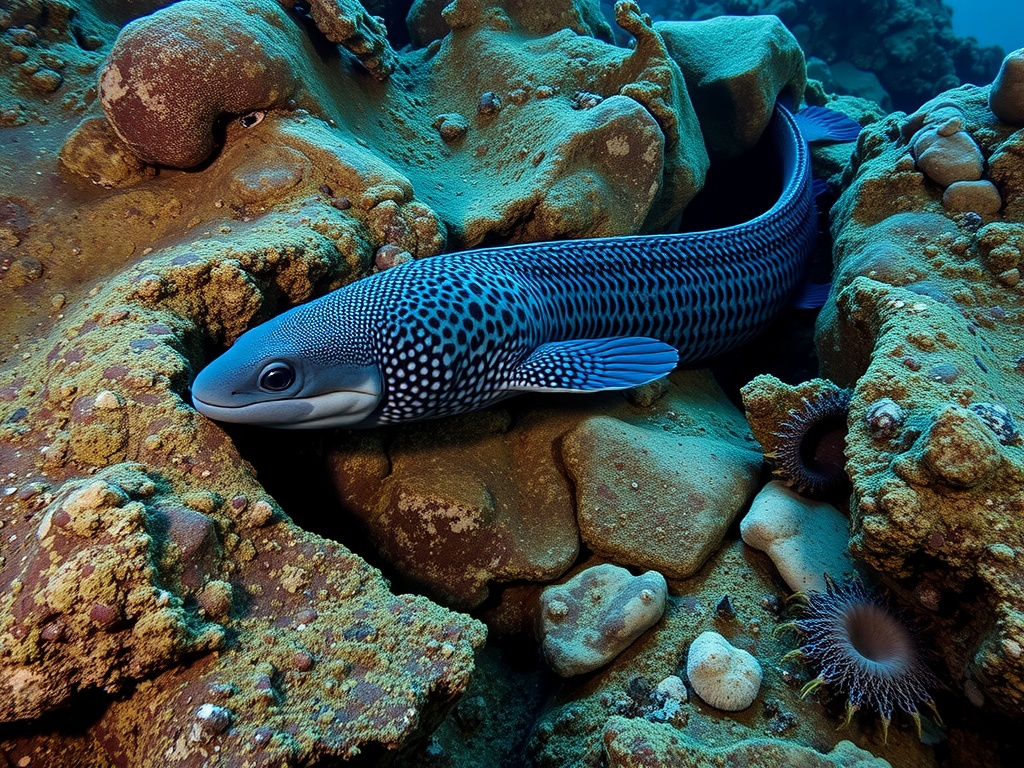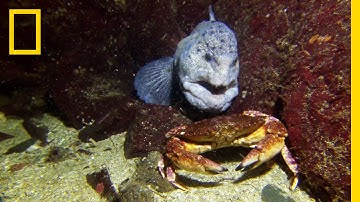
Wolf Eel
Anarrhichthys ocellatus

Meet the Wolf Eel
The wolf eel is a unique species of marine fish known for its long, eel-like body and large, powerful jaws lined with sharp teeth. Despite its somewhat fearsome appearance, it is generally shy and spends much of its life hiding in rocky crevices along the North Pacific coastline. Wolf eels are monogamous and often form lifelong pairs that share the same den. They play an important role in the ecosystem by preying on hard-shelled invertebrates such as sea urchins and crabs.
Classification
Fish
Habitat
Rocky reefs and crevices in the North Pacific Ocean
Diet
Carnivore
Lifespan
20-25 years
Conservation
Least Concern
Weight
13-18 kg
📖Fascinating Facts
Powerful Jaws
Wolf eels possess strong jaws and molar-like teeth, which allow them to crush the hard shells of crustaceans, mollusks, and sea urchins.
Lifelong Pairs
Once they find a mate, wolf eels typically form a monogamous pair and share the same den for life, working together to protect their eggs.
Coastal Dwellers
Wolf eels are found along rocky reefs and in crevices from the Sea of Japan, throughout the Aleutian Islands, and down to California.
📋Detailed Description
The wolf eel (Anarrhichthys ocellatus) is a large, elongated marine fish reaching lengths up to 2.4 meters (8 feet) and weights of up to 18.6 kg (41 lbs), making it the largest member of the family Anarhichadidae. Its body is serpent-like but muscular, with a broad, flattened head and a powerful jaw structure equipped with canine-like front teeth and molariform rear teeth, specialized for crushing hard-shelled prey. The skin is thick and scaleless, covered in a layer of mucus that provides protection from abrasion and parasites. Coloration changes with age: juveniles are orange with dark spots, while adults develop a slate gray to brownish hue with scattered dark spots and distinctive ocelli (eye-like spots) on the posterior dorsal fin. Wolf eels inhabit rocky reefs and kelp forests from the Sea of Japan and the Aleutian Islands south to California, typically at depths of 1–226 meters (3–741 feet). They are secretive and spend most of their lives in narrow crevices or caves, emerging primarily to feed. Socially, wolf eels are notable for forming long-term monogamous pairs that share dens, often for life. Their robust dentition and jaw musculature allow them to prey on hard-shelled invertebrates such as sea urchins, crabs, mollusks, and occasionally fish. Despite their intimidating appearance, wolf eels are generally docile and display complex behaviors, including pair bonding, cooperative den defense, and parental care.
💡 Did you know?
Wolf eels are known to become quite tame and even recognize individual divers who regularly visit their dens.
🔬Research & Sources
Wikipedia Summary
The wolf eel is a species of marine ray-finned fish belonging to the family Anarhichadidae, the wolf fishes. It is found in the North Pacific Ocean. Despite its common name and resemblance, it is not a true eel. It is the only species in the monotypic genus Anarrhichthys.
Last Modified: 4/24/2025
🎭Behavior & Social Structure
Wolf eels are primarily crepuscular and nocturnal, becoming most active during dusk and night. They exhibit strong site fidelity, rarely venturing far from their chosen den except to forage. Hunting involves slow, deliberate movements; they use their sensitive lateral line system to detect prey hidden among rocks. Once prey is located, the wolf eel uses its powerful jaws to crush shells and exoskeletons. Socially, bonded pairs often engage in mutual grooming behaviors and may jointly defend their territory from intruders. During the day, both individuals typically remain within their den, coiling together or resting side by side. Juveniles are more solitary and pelagic, seeking shelter in kelp or floating debris until they mature and establish a den. Wolf eels communicate through body postures and subtle movements, and aggression is rare except during territorial disputes or mating.
👶Reproduction & Life Cycle
Wolf eels are oviparous, with breeding typically occurring from October to late winter, varying by latitude. Monogamous pairs engage in elaborate courtship rituals, including synchronized swimming and gentle nipping. The female lays between 7,000 and 10,000 large, yellowish eggs in a single clutch, which she coils around and aerates with undulating body movements. Both parents guard the eggs, but the female provides most of the direct care, fanning and protecting them from predators and debris. Incubation lasts 91–112 days, depending on water temperature. After hatching, larvae are planktonic for several months before settling to the benthos as juveniles. Parental care is notable among marine fishes, with both adults remaining vigilant until the young disperse.
🛡️Adaptations & Survival
Wolf eels possess several adaptations for their rocky, high-energy habitats. Their elongated, flexible bodies allow them to navigate narrow crevices and caves, providing protection from predators and strong currents. The robust dentition and jaw musculature are evolutionary specializations for durophagy—feeding on hard-shelled prey. Their reduced swim bladder and heavy musculature enable them to maintain position in turbulent waters without floating away. The thick, mucous-covered skin acts as a barrier against parasites and abrasions. Their cryptic coloration provides camouflage among rocks and kelp, aiding in both predator avoidance and ambush predation. Socially, long-term pair bonding and cooperative parental care increase reproductive success in a challenging environment.
📚Research Sources
🎨Cultural Significance
Wolf eels have a modest role in indigenous cultures of the Pacific Northwest, sometimes appearing in oral traditions and as a food source, though they are not a primary target species. Their unusual appearance and docile nature have made them popular in public aquaria, where they are often used as educational ambassadors for rocky reef ecosystems. In some local folklore, their fearsome visage is contrasted with their gentle behavior, symbolizing the idea that appearances can be deceiving. There are no widespread traditional uses, but they are occasionally featured in regional art and storytelling.
🔬Recent Research & Discoveries
Recent research has focused on the reproductive biology and social behavior of wolf eels, revealing complex pair bonding and extended parental care unusual among marine fishes. Studies using underwater video and tagging have documented site fidelity, den sharing, and habitat preferences. Ongoing research is examining the impact of environmental changes, such as ocean acidification, on their prey base and reproductive success. Genetic studies have clarified their phylogenetic position as the sole member of the genus Anarrhichthys, distinct from true eels and other wolf fishes. There is also interest in their potential as a model for studying durophagous (hard-prey-eating) adaptations in fishes.
🎥Wildlife Videos

Wolf Eel | Amazing Animals
About Amazing Animals: Amazing Animals is a series that profiles a different animal in each episode. These short, one-minute ...
Nat Geo Kids

Meeting the Incredible WOLF EEL | Deadly 60 | BBC Earth
Welcome to BBC EARTH! The world is an amazing place full of stories, beauty and natural wonder. Here you'll find 50 years worth ...
BBC Earth

Meet the Intimidating Eel That Mates For Life | National Geographic
#NationalGeographic #WolfEels #MateForLife About National Geographic: National Geographic is the world's premium ...
National Geographic

Hungry Wolf Eel Isn't Scared of Humans | Deadly 60 | BBC Earth Explore
Deadly 60: Steve Backshall and his team track down some of the world's deadliest animals. From lethal beauties to killer beasts, ...
BBC Earth Explore

Wildlife - The Fascinating World of Wild Animals | Full Series | Free Documentary Nature
Wildlife - The Fascinating World of Wild Animals | Wildlife Documentary Watch 'Ocean Stories - Full Series' here: ...
Free Documentary - Nature

Moray Eels are Straight out of Alien
----------- SOCIAL MEDIA https://www.instagram.com/animalogicshow/ https://twitter.com/animalogicshow ...
Animalogic
🌍Habitat Information
The Wolf Eel typically inhabits Rocky reefs and crevices in the North Pacific Ocean environments. Wolf Eels have adapted to their environments with specialized features and behaviors.
Primary Habitat:
Rocky reefs and crevices in the North Pacific Ocean
More detailed habitat information will be available soon.
🛡️Conservation Status
The Wolf Eel is currently classified as Least Concern. Conservation efforts are crucial for preserving this species for future generations.
Common Threats:
- 🏠Habitat loss and fragmentation
- 🌡️Climate change impacts
- 🎯Hunting and poaching
- 🏭Human-wildlife conflict
⚠️Threats & Conservation Challenges
Currently, the wolf eel is listed as Least Concern by the IUCN, with no major widespread threats identified. However, localized challenges include bycatch in commercial fisheries, habitat degradation from coastal development, and collection for public aquaria. Their site fidelity and slow reproductive rate make them vulnerable to overharvesting in some regions. Ocean acidification and warming may impact prey availability and reproductive success in the future. Population trends are generally stable, but continued monitoring is recommended, especially in areas of high human activity.
🔬Scientific Classification
Scientific Name
Anarrhichthys ocellatus
Classification Hierarchy
🔍 About Taxonomic Classification
Taxonomic classification is a hierarchical system used by scientists to classify and organize living organisms based on shared characteristics and evolutionary relationships.
The system moves from broad categories (Kingdom) to increasingly specific ones, with each animal's scientific name typically consisting of its Genus and species.
📝Community Notes
Share your observations and insights about the Wolf Eel with our community of wildlife enthusiasts.
Join Our Community
Sign in to share your observations and connect with fellow wildlife enthusiasts.
Sign In to ContributeNo community notes yet
Be the first to share your observations about the Wolf Eel!
Explore Wolf Eel
Select a tab above to learn more about this amazing animal.
📸Photo Gallery
No photos available for this animal yet.
🌟Discover More Wildlife
Continue your journey of discovery with more fascinating animals from our database
